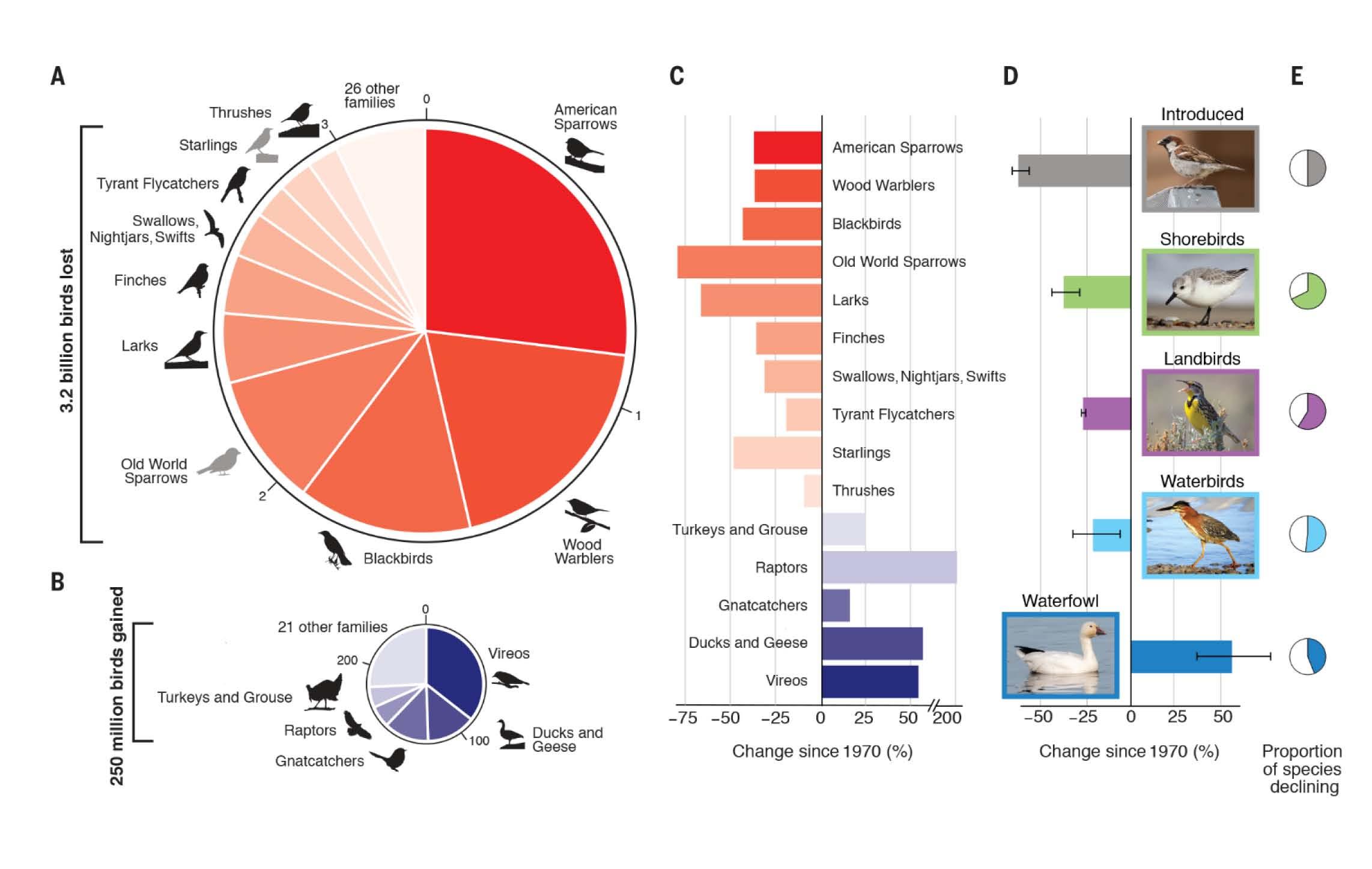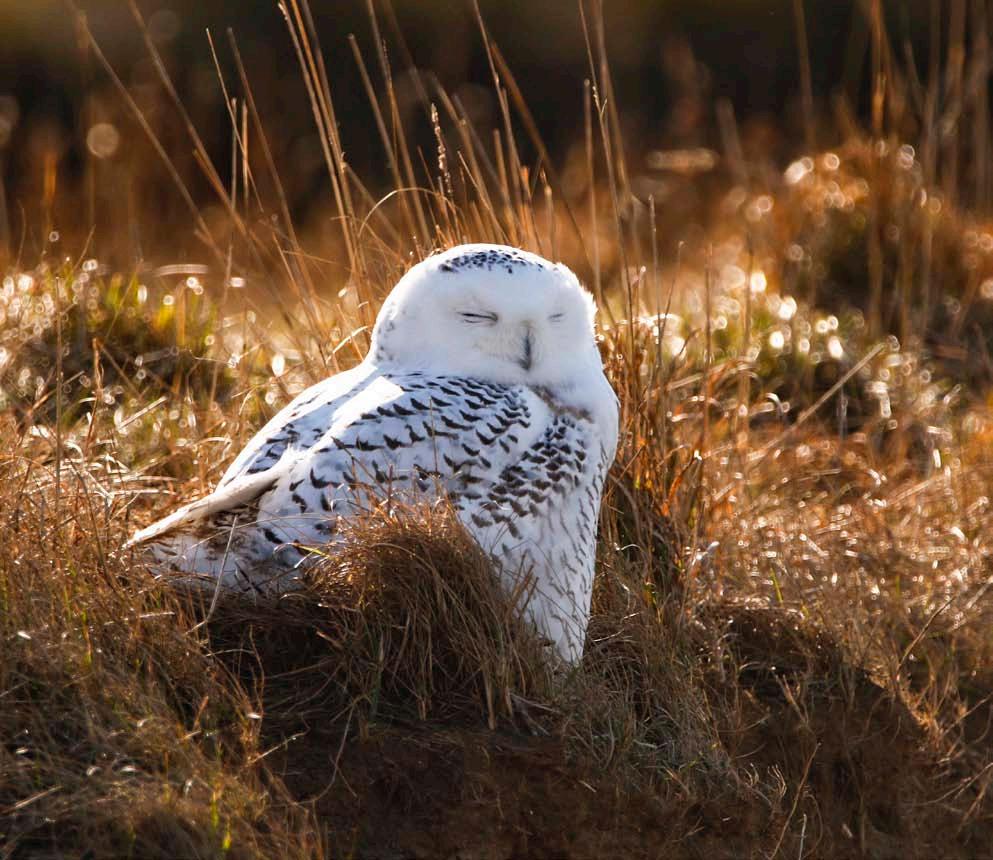
6 minute read
Devastation in the Skies
Confirming a huge decline in bird populations over the past five decades, scientists say much needs to be done, and quickly, to avert even greater losses. But they also say birds are resilient and can rebound, given the right conditions.
BY CHRIS ROSE
Advertisement
When Adam Smith first saw the results of a massive study on declining bird populations in the U.S. and Canada, he was sure he had made some sort of terrible mistake.
He simply could not believe what his computer was showing: a drop of three billion breeding birds since 1970, three billion of the estimated total 10 billion birds throughout the U.S. and Canada.
But after checking various factors, it became clear there was no error, said Smith, senior biostatistician for Canadian Wildlife Service, Environment and Climate Change Canada. Smith was one of the co-authors of the alarming study published Sept. 19, 2019 in the respected journal Science, which revealed the populations of 529 bird species in the U.S. and Canada dropped 29 percent between 1970 and 2018. “I was the analytical computational work horse,” Smith told the Wild Bird Trust in an interview from Ottawa. “The three-billion [bird decline] figure was generated on my computer.”
“My initial reaction was one of shock and perhaps despair,” he said. “I think it’s striking that there has been this extreme change…across an entire continent in less than the span of a human lifetime.”

Snowy Owl
Photo: DeborahJohnston/Audubon Photography Awards

Red-headedWoodpecker
Photo: Gary Robinette/Audubon Photography Awards
Described as the most comprehensive bird survey ever conducted in the two nations, the report also noted that the passage of migrating birds in the countries declined 13 percent between 2007 and 2017.
The study was conducted by Cornell University, American Bird Conservancy, Environment and Climate Change Canada, United States Geological Survey, Bird Conservancy of the Rockies, and Smithsonian Conservation Biology Institute.
Ken Rosenberg, the first author of the study and a conservation scientist at the Cornell University Laboratory of Ornithology, called the results staggering.
“This loss of bird abundance signals an urgent need to address threats to avert future avifaunal collapse and associated loss of ecosystem integrity, function and services,” the study noted.
The findings raise fears that some familiar species could go the way of the Passenger Pigeon, a species once so abundant that its extinction in early 1900s seemed unthinkable.
It adds bird populations flying U.S. and Canadian skies have significantly decreased since 1970 in all habitats except for wetlands. Birds using grassland habitats were the most adversely affected, down about 53 percent, or more than 717 million breeding individuals.
The three bird habitats that occur in British Columbia include Boreal forests, Western forests and Arid lands. Across both countries, Boreal forest birds decreased by 33 percent, a loss of 500 million birds. Western forest birds declined by 29.5 percent, a loss of 140 million, and Arid lands populations dropped 17 percent, or almost 50 million birds.
“We were very surprised when we saw a net loss of three billion birds across all species,” Rosenberg told the Wild Bird Trust. He said governments have to play a significant role in assisting bird populations because changes need to happen on a massive scale. Individuals, he added, will have to take a stand politically to pressure governments to strengthen environmental policies.
While the study findings are distressing, he noted that the bird loss is not irreversible. “We know that bird populations are resilient,” Rosenberg said.
David Yarnold, president of the National Audubon Society, was also shocked by the study.
“This is a full-blown crisis that requires political leadership as well as mass individual action,” he added. “We have to act now to protect the places we know birds rely on.”
Audubon said the bird declines are a result of human activity, including habitat loss, agriculture, urban development, predation from outdoor cats, collisions with buildings and windows, and widespread pesticide use.
“Birds are excellent indicators of environmental health. Severe declines in common birds, like those shown in this study, tell us something is wrong and underscores the need to become better stewards of the planet,” said Nicole Michel, Audubon’s senior quantitative ecologist.

Net population change in North American birds.
Source: K. V. Rosenberg et al., Science 10.1126/science.aaw1313 (2019).
A New York Times story about the study quoted Hillary Young, a conservation biologist at the University of California, Santa Barbara, saying that stopping the massive bird decline would require an immense effort including defending habitats, restricting chemicals and redesigning buildings.
“We’re overusing the world, so it’s affecting everything,” Young said.
The study was published four months after the second State of Canada’s Birds report, conducted by the North American Bird Conservation Initiative in Canada, under the leadership of Environment and Climate Change Canada, Bird Studies Canada, Nature Canada and Ducks Unlimited Canada.
The State of Canada’s Birds report had many similar findings to the Science study, saying “human activities have resulted in dramatic changes to Canada’s bird populations over the last 50 years.”
Looking at 449 Canadian bird species, the report noted Canada has lost 40 percent to 60 percent of shorebird, grassland bird and aerial insectivore populations in the past five decades.
“The loss of important lands and waters, unsustainable agricultural practices, climate change and pollution are the most important causes of these declines,” according to the NABCI-Canada.
“These threats affect birds on their Canadian breeding grounds, during their migration and on their wintering grounds, highlighting the need for strong international conservation action.”
Smith said habitat loss and habitat degradation are the major factors that have driven the bird declines in the past five decades. “In the future, of course, climate change will almost certainly exacerbate and magnify the problem.” If there is any good news in the findings, he said, wetland birds have increased by almost 14 percent. “They are a guiding light to show us the way to help the rest of the fauna in North America.” Raptors are another species that have increased, he added, because of bans on the disgraced pesticide DDT.
Smith noted international cooperation and broad systemic changes are the key to improving stressed bird populations. “The fact we have lost more than a quarter of the birds is profoundly important.”
David Bradley, director of the B.C. office for Bird Studies Canada, also said he was shocked by the study findings. “It’s enough to shock anyone — three billion birds,” Bradley said. “I mean, three billion is hard to fathom what it really means.” Describing the study as a “wake-up call,” he added both governments and citizens can do a number of things to help ailing bird populations.
Strong government legislation and regulations are vitally important in protecting the environment and managing land that birds depend on, Bradley said, while people can also make a number of small yet beneficial changes in their day-to-day lives.
Lindsey Ogston, a biologist and the environmental program manager for the Tsleil-Waututh Nation, said that while the recent Science study was disturbing, there are many signs indicating that different aspects of the larger ecosystem are also under attack.
“It’s almost not that shocking anymore,” she said. “It’s not just the birds . . . These things don’t just happen in a vacuum.”
Confirming a huge decline in bird populations over the past five decades, scientists say much needs to be done, and quickly, to avert even greater losses. But they also say birds are resilient and can rebound, given the right conditions.










